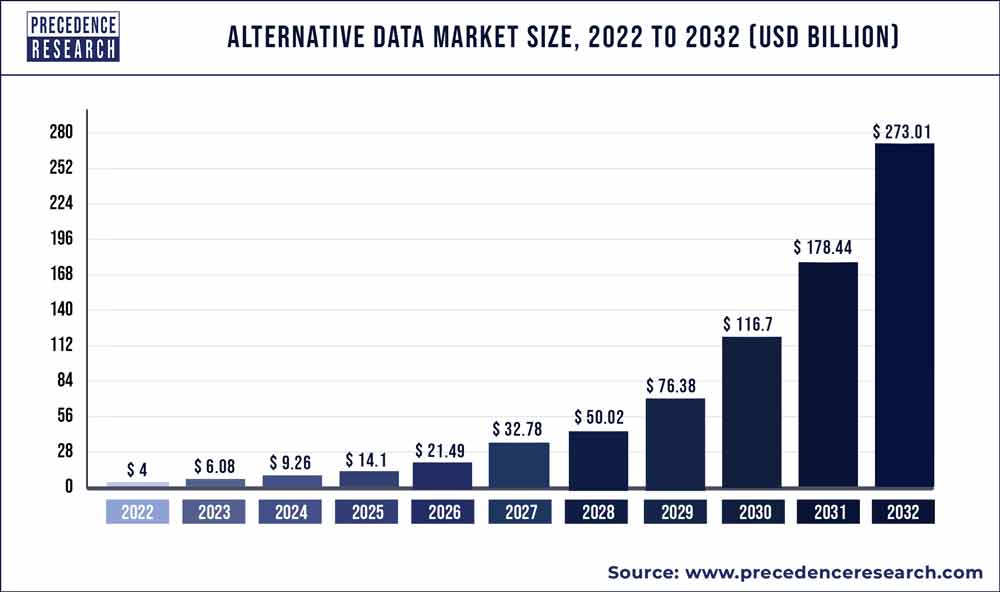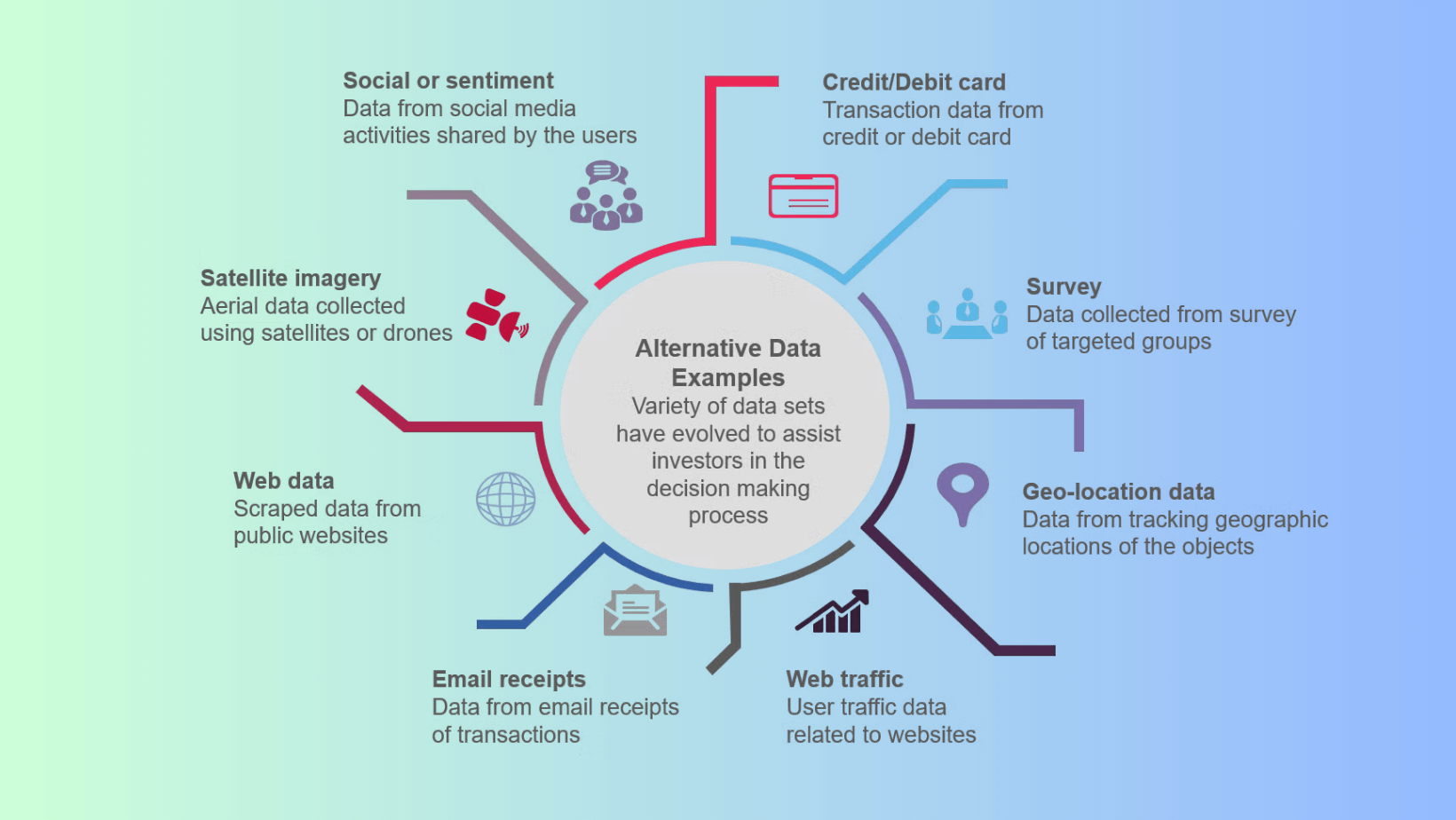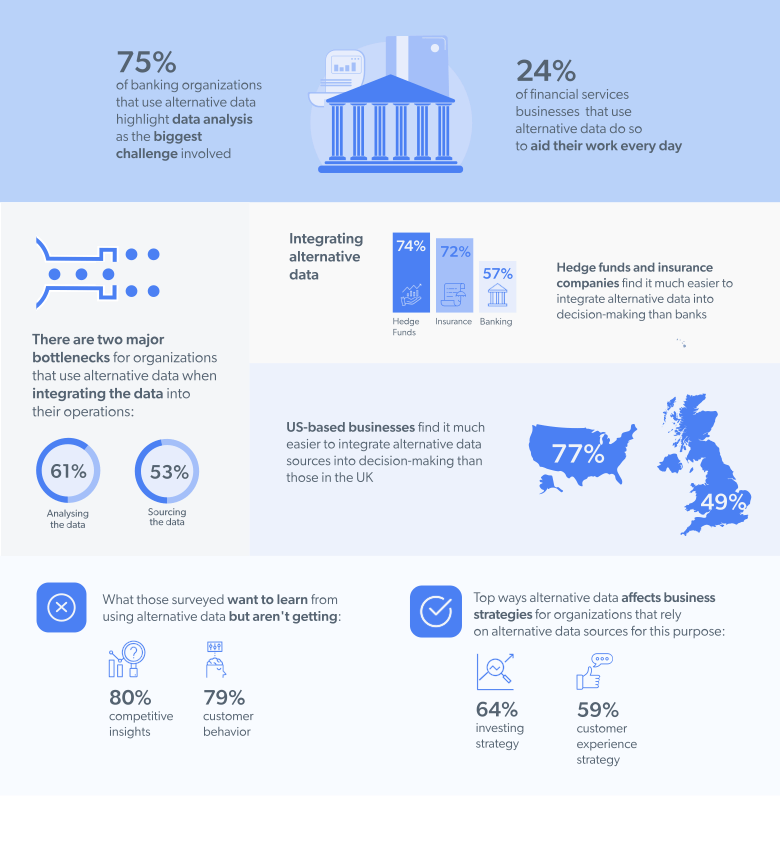
The Rise of Alternative Data Use is Financial Investment Strategies
20 December, 2023
Alternative data refers to information obtained from non-traditional sources that is not typically used by investors. In recent years, alternative data has grown substantially in popularity among the investment community as a way to generate excess returns and better manage risks.
The Rise of Alternative Data - Forecasting the Next Big Trend
The financial data industry is undergoing a seismic shift as alternative data sources gain widespread adoption. Traditional sources like earnings reports and balance sheets only tell part of the story about public companies. A new class of "alternative" data from non-traditional sources is providing investors with invaluable insights to identify opportunities and risks that may not be reflected in stock prices.
Rather than solely relying on standard industry data sets, alternative data incorporates a wide variety of unconventional datasets into the investment process. Alternative data comes from sources like satellite imagery, social media activity, credit card transaction records, internet of things (IoT) sensor readings, mobile device location information, product reviews, website traffic analytics, weather patterns, app usage metrics, and environmental, social, and corporate governance (ESG) reports and other real-world signals that can impact company financials. As more investors recognize the value of this data, the alternative data market is experiencing explosive growth.
By analyzing alternative data sources, investors aim to gain insights that extend beyond what can be learned from traditional financial statements, stock prices, and macroeconomic indicators. Mining alternative data pools can uncover trends and patterns that are not readily apparent in standard data sets.
As technology advanced how data is captured and shared, the availability of alternative data exploded in recent times. Savvy investors now leverage diverse non-traditional datasets to inform investment strategy, perform risk management, and potentially identify alpha opportunities that may not be visible to others relying solely on conventional sources. In summary, alternative data plays an increasingly important role in powering investment decisions through the lens of unique and untapped information sources.
Market Projections Show Huge Potential
The alternative data industry is poised for massive growth according to market research. Grand View Research estimates the global alternative data market was worth $1.8 billion in 2020 and is projected to explode at a jaw-dropping 53.2% compound annual growth rate to reach over $30 billion by 2028.
Other analysts believe the market could surpass even loftier heights of $50 billion as early as 2025. Still a niche sector currently, the alternative data field is dominated by a select number of players.

However, the following factors are fueling a rapid expansion:
- Rising Demand: Investors increasingly seek alternative data to generate excess returns and better manage portfolio risks.
- Growing Availability: As more datasets are captured and shared through advancing technology, the pool of available alternative data swells daily.
- Analytic Advances: New tools help process immense troves of unstructured alternative data and extract valuable insights.
The market is also characterized by cutting-edge innovation, as providers constantly debut novel alternative data products and analytics.
These projections reflect how alternative data is becoming mainstream across finance. Already, major investment banks, asset managers, quant funds, and individual traders recognize it delivers an information edge.
As higher quality datasets emerge and tools enhance, alternative data usage will only rise further. Within a few short years, it will be standard practice integrated across all areas of financial markets. The future remains hugely promising for this burgeoning big-data revolution in investing.
Drivers in the Alternative Data Market Growth
Alternative data comes from unconventional sources like social media, web traffic, public records, mobile devices, and more. When analyzed, it provides unique insights not found elsewhere.
Buy-side firms such as hedge funds, mutual funds, and pension funds are increasingly using alternative data in their models. This gives them an edge to outperform the market.
Initially adopted by quant traders, alternative data is now used widely across the institutional investment community and in corporations.
Fund managers also seek alternative data to pick stocks in this new economic environment and find new sources of returns.
The COVID-19 pandemic accelerated alternative data's role. Businesses now track consumer behavior changes using sources like social media, apps, and IoT to understand purchasing trends.
Both buy-side and sell-side want more information on alternative data due to pandemic-driven behavioral shifts.
Hedge funds are a major driver of growth. Over half now use it for outperformance and risk management.
More than 400 alternative data vendors serve this demand, fueling rising revenue in the market.
The key points are that alternative data comes from non-traditional sources and provides unique insights. Its use is expanding from quant traders to broader institutional investors and corporations. The pandemic further increased interest in understanding consumer behavior changes through alternative data sources.
Alternative Data Sources
Beyond traditional SEC filings and reports lies a rich trove of undiscovered data sources offering real-time insights into demand, supply chains, and more. Some that provide cutting-edge signals include:

- Satellite imagery: Tracking everything from foot traffic and inventory to energy usage at commercial and industrial sites.
- Social media scraping: For qualitative sentiment analysis and clues to shifting consumer behaviors across diverse online communities.
- Credit card transactions: Revealing spending pattern adjustments nationwide.
- Digital interactions mining: Qualitative nuggets from sources like job posts, company reviews, and industry forums.
- Sensor and IoT data: Quantifying infrastructure usage, fleet management, and other operational metrics.
- Public video and images: Harvested from global news outlets for contextual understanding.
Projected Growth Drivers:
Social media sentiment analysis and mobile app usage data are poised for significant increases as retailers leverage these sources to better understand e-commerce behaviors across demographics and locations.
Geolocation data from satellite photos is growing in popularity for assessing store visit patterns on specific days/times, helping optimize operations.
While less precise than transactions, businesses are learning to connect these dots and glean actionable consumer insights to inform strategic decisions.
These diverse alternative datasets offer a rich real-time snapshot to complement traditional sources as analytics capabilities advance.
Innovative Solutions and Alternative Data Platforms
The surge in demand has turbocharged innovation in alternative data sources and providers. Companies are emerging to collect, organize, and analyze new types of “found” data scraped from online sources. Others are deploying tech like computer vision, natural language processing, and sensors to extract insights from visual, textual, and location-based feeds in novel ways.
Sophisticated FinTech startups are developing specialized datasets and analytics applications. Meanwhile, traditional data vendors are expanding their collections through acquisitions or internal R&D efforts. More alternative data brokers are filling the role of matching buyers and sellers. This proliferation of supply options allows investors to customize alternative data strategies based on their sectors, markets, or investment styles.

Advantages of Alternative Data:
- Untapped Alpha Potential: Alternative data gives investors access to insights not reflected in traditional sources, helping them identify opportunities earlier for potential outperformance.
- Risk Reconnaissance: Its unmined nuggets provide visibility into risks like demand trends, supply chain issues, and geographic impacts enhancing risk management.
- Portfolio Stealth Mode: These new lenses optimize portfolio allocation by revealing how different assets may perform in various conditions, complementing backward-looking analysis.
- Compliance Tailwinds: Its real-time views of customers and markets assist with diligently following regulations by enhancing understanding of businesses and their implications.
Alternative data's fresh perspectives equip investors with forward-looking alpha generation, risk avoidance, strategic allocation, and compliance support far beyond traditional sources - giving them an informational edge in volatile markets. Its diverse, timely signals provide multidimensional insights invaluable for outmaneuvering challenges and grasping opportunities institutional investors cannot afford to overlook.
The Rising Tide of Alternative Data
Alternative data is poised to revolutionize investing as it emerges as a rapidly growing new paradigm. Rather than relying solely on traditional sources, forward-thinking investors are tapping into alternative data's treasure trove of insights. This emerging trend offers significant advantages for alpha generation, risk management, portfolio optimization, and regulatory compliance.
Demand is surging as investors recognize alternative data's powerful benefits. Through specialized analytics, it provides an informational edge for spotting market shifts and opportunities before competitors. This allows for more accurate fundamental analysis and modeling compared to backward-looking public reports. Alternative data also enhances risk assessment by signaling potential issues within a company.

Beyond individual stocks, alternative data improves macroeconomic forecasting with real-time indicators of shifts in the business cycle. As technologies advance, its applications will expand to include specialized investment strategies targeting niche consumer or industry behaviors. The wave of alternative data carries expanding opportunities for innovators to catch market-moving trends at the forefront.
Rapid technological evolution and regulatory changes are fueling exponential projected growth for this big data revolution. Savvy quantitative investors positioning themselves at the vanguard now will achieve significant competitive advantages in coming years. Those leveraging alternative data sources through sophisticated quantitative methods stand to gain a competitive edge in areas like alpha generation, risk resilience during disruptions, and outperformance across market cycles.
The rising tide of alternative data offers expanded possibilities for forward-thinking investors willing to ride this new wave of returns. Those surfing alternative data's potential now will be best positioned to catch the biggest swells in the years ahead.